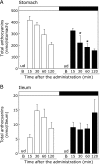Diurnal rhythmicity in biological processes involved in bioavailability of functional food factors
- PMID: 23704810
- PMCID: PMC3651920
- DOI: 10.3164/jcbn.12-127
Diurnal rhythmicity in biological processes involved in bioavailability of functional food factors
Abstract
In the past few decades, many types of functional factors have been identified in dietary foods; for example, flavonoids are major groups widely distributed in the plant kingdom. However, the absorption rates of the functional food factors are usually low, and many of these are difficult to be absorbed in the intact forms because of metabolization by biological processes during absorption. To gain adequate beneficial effects, it is therefore mandatory to know whether functional food factors are absorbed in sufficient quantity, and then reach target organs while maintaining beneficial effects. These are the reasons why the bioavailability of functional food factors has been well investigated using rodent models. Recently, many of the biological processes have been reported to follow diurnal rhythms recurring every 24 h. Therefore, absorption and metabolism of functional food factors influenced by the biological processes may vary with time of day. Consequently, the evaluation of the bioavailability of functional food factors using rodent models should take into consideration the timing of consumption. In this review, we provide a perspective overview of the diurnal rhythm of biological processes involved in the bioavailability of functional food factors, particularly flavonoids.
Keywords: bioavailability; diurnal rhythmicity; flavonoids; functional food factors; rodents.
Figures



Similar articles
-
Time-Restricted Feeding Prevents Ablation of Diurnal Rhythms in Gastric Vagal Afferent Mechanosensitivity Observed in High-Fat Diet-Induced Obese Mice.J Neurosci. 2018 May 30;38(22):5088-5095. doi: 10.1523/JNEUROSCI.0052-18.2018. Epub 2018 May 14. J Neurosci. 2018. PMID: 29760179 Free PMC article.
-
Safety and nutritional assessment of GM plants and derived food and feed: the role of animal feeding trials.Food Chem Toxicol. 2008 Mar;46 Suppl 1:S2-70. doi: 10.1016/j.fct.2008.02.008. Epub 2008 Feb 13. Food Chem Toxicol. 2008. PMID: 18328408 Review.
-
Diurnal rhythms in calcium and phosphate metabolism in rodents and their relations to lighting and feeding schedules.Miner Electrolyte Metab. 1985;11(3):158-66. Miner Electrolyte Metab. 1985. PMID: 4040208
-
Dietary flavonols: chemistry, food content, and metabolism.Nutrition. 2002 Jan;18(1):75-81. doi: 10.1016/s0899-9007(01)00695-5. Nutrition. 2002. PMID: 11827770 Review.
-
Effects of light and melatonin treatment on body temperature and melatonin secretion daily rhythms in a diurnal rodent, the fat sand rat.Chronobiol Int. 2010 Aug;27(7):1401-19. doi: 10.3109/07420528.2010.505355. Chronobiol Int. 2010. PMID: 20795883
Cited by
-
Active-phase Plasma Alkaline Phosphatase Isozyme Activity Is a Sensitive Biomarker for Excessive Fructose Intake.In Vivo. 2023 Sep-Oct;37(5):1967-1974. doi: 10.21873/invivo.13293. In Vivo. 2023. PMID: 37652475 Free PMC article.
-
Nocturnal light exposure alters hepatic Pai-1 expression by stimulating the adrenal pathway in C3H mice.Exp Anim. 2014;63(3):331-8. doi: 10.1538/expanim.63.331. Exp Anim. 2014. PMID: 25077763 Free PMC article.
References
-
- Sasaki S. Dietary Reference Intakes (DRIs) in Japan. Asia Pac J Clin Nutr. 2008;17 (Suppl 2):420–444. - PubMed
-
- Shibamoto T, Kanazawa K, Shahidi F, Ho CT, editors. Functional Food and Health, ACS Symposium Series 993. Washington DC: ACS Publications; 2008. pp. 1–514.
-
- Sakakibara H, Ashida H, Kanazawa K. A novel method using 8-hydroperoxy-2'-deoxyguanosine formation for evaluating antioxidative potency. Free Radic Res. 2002;36:307–316. - PubMed
-
- Sakakibara H, Honda Y, Nakagawa S, Ashida H, Kanazawa K. Simultaneous determination of all polyphenols in vegetables, fruits, and teas. J Agric Food Chem. 2003;51:571–581. - PubMed
-
- Terao J. Flavonols: metabolism, bioavailability, and health impacts. In: Fraga C, editor. Plant Phenolics and Human Health. Hoboken: John Wiley & Sons, Inc.; 2010. pp. 185–196.
LinkOut - more resources
Full Text Sources
Other Literature Sources
Miscellaneous

